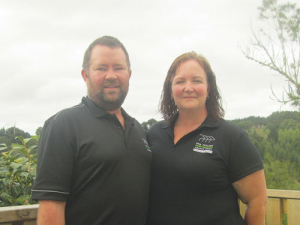It is serious and widespread in New Zealand, an estimated 60% of dairy and beef cows having been exposed to the disease.
BVD infection can have major impacts during mating and pregnancy.
It can cause infertility, embryo loss, abortions (slips), small slow-growing calves, deformed calves and the birth of dead calves.
The most damage is done when BVD infects pregnant cows. If a cow contracts BVD in the first four months of pregnancy while the developing calf’s own immune system is forming, she may give birth to a persistently infected (PI) calf. PI animals are the main source of infection within a herd.
Farmers share BVD experience
Northland Share Farmers of the Year Glen and Trish Rankin know this all too well.
Four seasons ago, as lower order sharemilkers with a herd of 300 cows, they had a serious BVD outbreak. The impact on the farm and the team was devastating. Rankin says he still shudders every time he thinks about the experience.
It started with a PI bull brought in for mating. The farm was part of three farms under the same ownership that were essentially closed herds, with all bulls born and reared on one location and provided for the other two farms. BVD was not considered a major risk, as outside bulls were not being purchased.
Rankin runs two bull teams with three bulls in each team. One bull didn’t look well but he didn’t think too much of it. Not until calving did the scale of the problem became apparent, he says.
“We had 50-60 dead and deformed calves: blind calves, calves with bows in the neck and calves born dead. Many
of the surviving calves were weak. Trish normally looked after the calves on her own, but when this happened, we needed 2.5 labour units to help.
“We were tubing 42 calves several times a day and the worst cases were also on IV drips.
“We were struggling
to keep them alive. Fifty calves made it through
to weaning but after BVD testing 12 PI calves had to be destroyed. The worst thing was they were 100kg healthy looking calves,
so PI calves aren’t always scrawny animals.”
By the time the Rankins found out what was causing the problem, they had unwittingly spread the infection by keeping their PI calves in the same pens as healthy animals.
PI calves are the main source of infection onfarm because they spread large amounts of the virus for their entire lives. Control them and you control the disease.
Rankin says they have learnt from the experience.
“We took pride in looking after our own and other people’s stock and we set high standards.
It was a case of shock and horror because we didn’t know what was happening. We were all beside ourselves. It was four years ago, but the experience is still fresh in our minds.”
What you can do
Rankin’s recommendations to other farmers:
Learn about the BVD disease so you can recognise the symptoms.
Know the status of all incoming stock by testing for BVD.
Test home-reared and brought in-bulls for BVD before they move, vaccinate the negative bulls and cull the positive bulls.
Test replacement calves. If they are infected and proven to be PIs they should be culled to prevent them from acting as a source of virus for the rest of the herd.
Bulk milk test and make sure you also test milk that’s not going into the vat. Test in groups and then individual animals if a positive result occurs.
Facts and figures
- Bovine viral diarrhoea (BVD) is widespread Most dairy herds in New Zealand have been exposed to the virus
- It causes reproductive losses, an increase in general disease, reduced growth rates and lowered milk production Losses are estimated at $70,000 per infected average-size herd each year
- Most BVD effects go undetected by farmers
- The disease is maintained in a herd and spread to other animals by persistently infected (PI) animals
- Throughout their lives, PI animals excrete large amounts of the virus This occurs when an early pregnant (first four months) cow gets infected with BVD The resulting calf is born PI
- To control the disease, you must prevent the formation of PI calves by making sure early- pregnant cows do not become infected with the virus
- Control is a four-step process:
- Define if BVD is in the herd
- Assess the level of risk for your farm
- Action a control plan to mitigate these risks
- Monitor to make sure it’s working
Ask your vet to work through the process with you. They have the tools to help control the disease.
*This article first appeared in Getting the Basics Right 2017 edition.
• Nita Harding is DairyNZ’s technical policy advisor (veterinary).


















